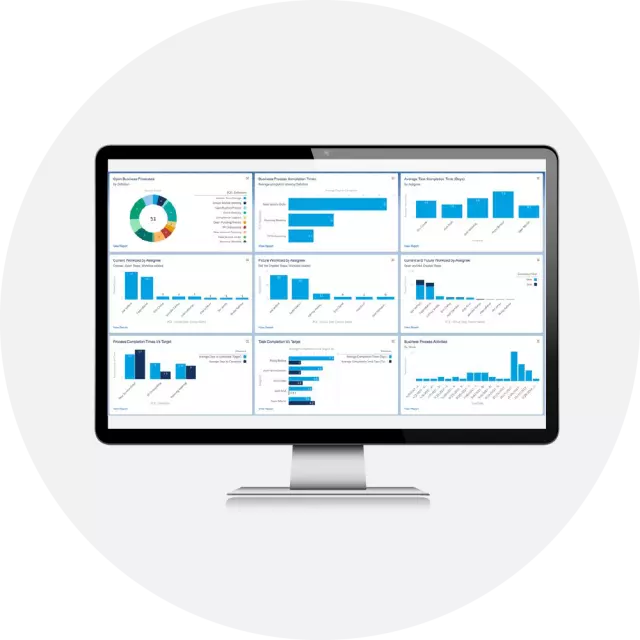
Cost optimization in an unpredictable market

In today's turbulent economic environment, every business is facing challenges related to cost management, financial resilience, and operational optimization. Long story short, we're all cutting costs. But achieving meaningful cost savings amid these volatile conditions is no small feat.
To unpack this important topic, Conga VP of Global Pre-Sales Nick McCoy recently hosted a webinar, Cost Optimization Unveiled: A CFO’s Guide to Financial Resilience in a Time of Economic Turbulence. He was joined by CFO Simon Edwards and Arun Saksena of Amazon Web Services (AWS), who shared their expert insights. The discussion covered several critical talking points, including:
- Today's unique business challenges, as seen through the lens of a CFO
- The nuances of the current economic landscape and how it impacts financial decision-making
- Avenues to drive cost optimization and business efficiency
- The power of strategic partnerships and innovative solutions in driving success
Following are some key takeaways from this insightful discussion. You can also view the on-demand webinar for more details.
Today’s CFO must help deliver business results
As every CFO knows, the world has become increasingly unpredictable. This fact is borne out by metrics like the World Uncertainty Index, which serves as a barometer for complexity in the global economic landscape. The WUI has been trending up for decades—with increased volatility—driven by factors like:
- Rising cost of capital
- Supply chain disruptions
- The rapid pace of technological advancements (like AI)
- Geopolitical instability
- And of course, our recent global pandemic
The fact is, financial leadership has evolved significantly, and the role of a CFO now includes far more than just number crunching. To be effective, today's CFO must also steer their organization through unpredictability and serve as a catalyst for efficiency, growth, and business success. In the context of cost optimization, this involves analyzing processes and implementing cost-cutting measures to increase organizational efficiency—and ultimately contribute directly to the bottom line.
Cost optimization is a differentiator for CFOs
Recent research from Gartner highlights the strategic impact of a CFO's approach to cost management and underscores its direct correlation to organizational success.
CFOs have a number of levers at their disposal to drive effective cost optimization, such as:
- Demand management and reduction
- Cost productivity
- Process simplification
- Vendor consolidation and pricing leverage
- Financial accountability
In the context of software procurement, it's critical that the CFO first aligns demand to the organization's objectives, in order to maximize the productivity of every dollar spent. This means not only purchasing software in optimal quantities (consumption or licenses), but also redesigning internal processes around software to simplify and streamline wherever possible.
CFOs also wield considerable influence in vendor management. Negotiating favorable terms and leveraging pricing agreements can result in substantial cost savings, while also building stronger partnerships with those vendors. And of course CFOs must foster a culture of financial responsibility, to ensure that every expenditure legitimately aligns with organizational goals.
The importance of financial operations and demand management
When it comes to third-party software, financial operations (or FinOps) has traditionally focused on chargebacks and cost allocation, to ensure the cost of cloud infrastructure is assigned to the appropriate cost center. But taking a more holistic approach to FinOps can improve financial accountability and bring more visibility into spending on third-party data services.
Why is this important? Spending on software and external data continues to grow at double-digit rates. In fact, some industry analysts have reported that software now constitutes the second largest expense category for most organizations. So it's critical to not only gain visibility into that spend, but also ensure it's tied to business outcomes.
Demand management also plays a key role in cost savings, by helping to drive smart, data-driven decisions around software sourcing and procurement. With proper demand management, it's possible to:
- Control SaaS sprawl by improving visibility into spending across the business and improving compliance with procurement policy
- Manage requirements and specifications to avoid over-provisioning of licenses and unused/unwanted features
- Change spending patterns through flexible licensing and contracting to meet the needs of the business
- Negotiate year-over-year price increase caps or even price reductions for multi-year contracts
Leveraging Conga + AWS Marketplace for cost optimization
Despite unprecedented market challenges and external pressures that impact every organization, customer expectations continue to grow. From increased efficiency and omnichannel buying experiences to contract acceleration to greater personalization, customer demands are setting the pace of transformation. And if companies fail to keep up with those demands, they cannot succeed.
So how can organizations reduce costs without sacrificing the innovations that drive business forward? Best-in-class companies recognize they must transform or be left behind. That's why they're focused on automating their revenue operations and using data-driven contract intelligence to serve their customers' needs better.
Conga business solutions are now available through the AWS Marketplace, a curated digital catalog that customers can use to find, buy, deploy, and manage software and services. Purchasing on the AWS Marketplace provides a number of key benefits:
- Peace of mind: AWS Marketplace features a curated selection of pre-vetted software solutions from reputable vendors, so you can be confident of the quality and security of software offerings.
- Cost optimization: AWS' consolidated billing simplifies the tracking and management of software-related expenses, providing improved visibility into software spend.
- Simplified procurement: AWS Marketplace provides a centralized platform for software selection, reducing the need to deal with multiple vendors and negotiate multiple contracts.
- Cloud spend retirement: By purchasing through the AWS Marketplace, your organization can retire its EDP spend commitment with AWS—essentially utilizing your existing budget to fund Conga solutions.
Combining the power of Conga + AWS Marketplace has already helped companies across variety of industries to solve their revenue operations pain points while optimizing IT spend. Here are just a few of their results:

For more detail and expert insights from this exclusive discussion—plus a lively Q&A session with our audience—you can watch the webinar recording on demand.
Read this data sheet to learn more about how Conga solutions in the AWS Marketplace can help improve cost optimization and increase revenue certainty.



